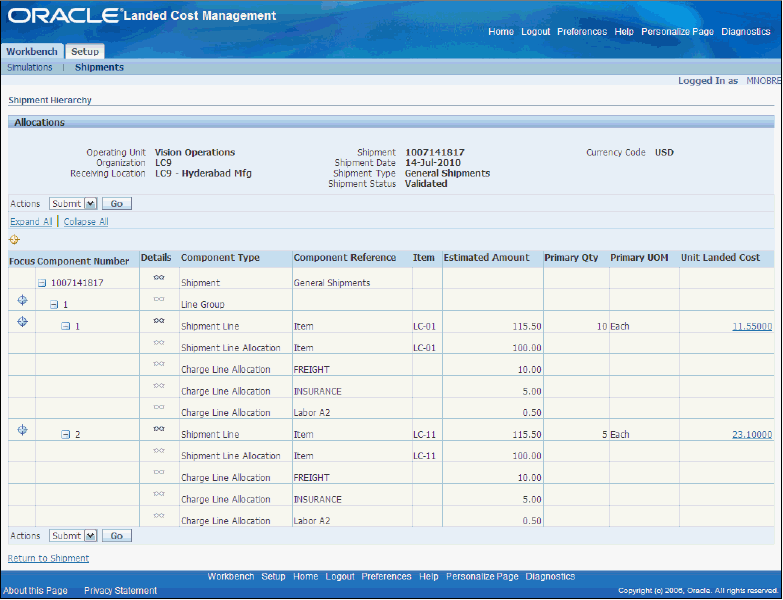Managing Simulated Landed Cost
This chapter covers the following topics:
- Understanding Simulated Landed Cost
- Creating a Landed Cost Simulation for a Purchase Order
- Reviewing Existent Landed Cost Simulations
- Managing Existent Landed Cost Simulations
- Managing Charges and Simulation Details
- Creating the Estimated Landed Cost Shipment
Understanding Simulated Landed Cost
Simulated Landed Cost functionality allows users to simulate the landed costs when creating a purchase order. This allows the buyer to perform better sourcing decisions by comparing the overall landed costs including all applicable charges instead of relying on the item price only. You can review the landed cost information simulations by editing the charges automatically calculated or create and delete new ones.
Simulated Landed Cost functionality is available for standard purchase orders as well as blanket releases.
See:
Creating a Landed Cost Simulation for a Purchase Order
Using the Landed Cost Simulations page, you can search for a purchase order for which to create a simulation.
Use this procedure to create a landed cost simulation:
To Create a Landed Cost Simulation:
-
Navigate to the Create or Update Standard Purchase Order page for the desired PO.
Please refer to the Oracle Purchasing User’s Guide for additional information on how to create Purchase Orders.
Standard Purchase Order page
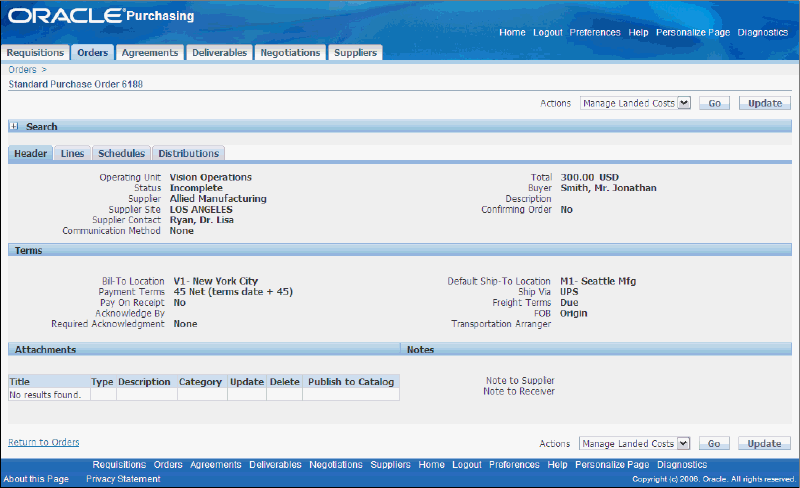
-
From the Actions menu, select Manage Landed Costs and click Go to display the Landed Cost Simulation page.
Standard Purchase Order page
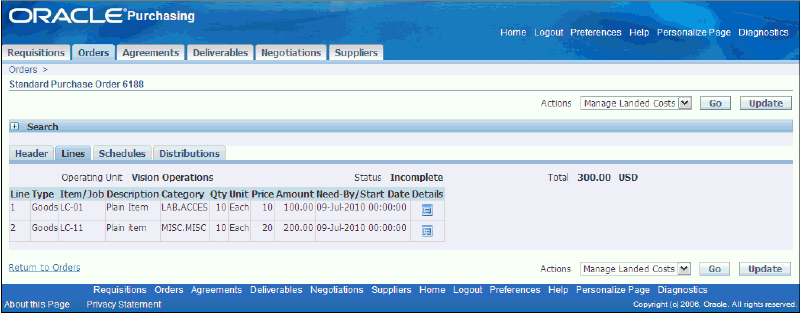
-
The Purchase Order information is automatically defaulted to the Landed Costs Simulations page.
Landed Cost Simulations page

-
Click the Simulate button. In the Simulations region, you can view the simulation information derived from the PO in the following columns:
-
Operating Unit
-
Third Party
-
Third Party Site
-
Freight Carrier
-
Source Order
-
Source Revision
-
Simulation Version Currency
-
Total Cost
-
Firmed
-
Actions
Landed Cost Simulations page
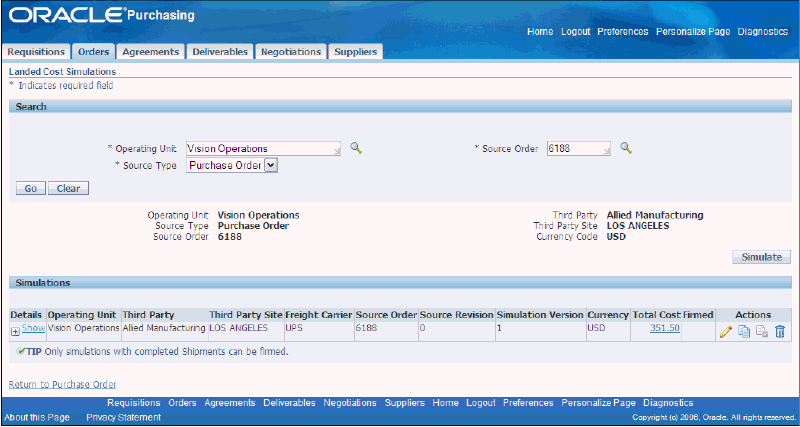
-
-
Click the Show link in the Details column to display details of the purchase order. The following columns are displayed for each line of the order:
-
Organization
-
Location
-
Shipment
-
Number
-
Status
-
Amount
-
Simulated
-
Update
Landed Cost Simulations page
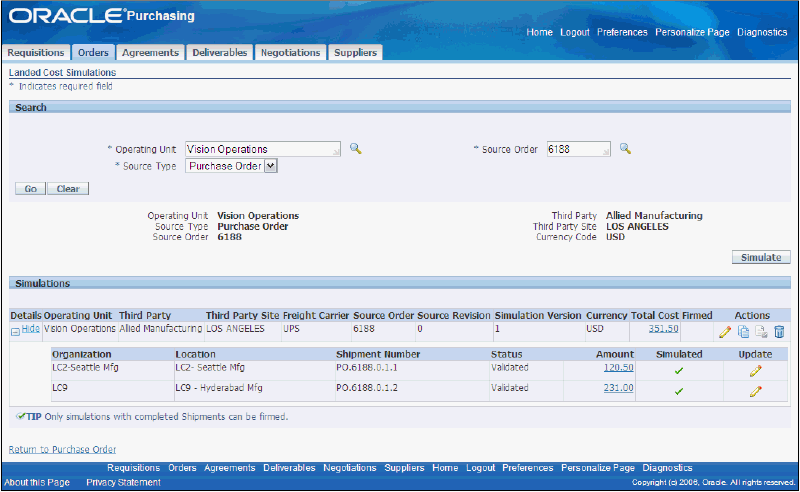
-
Reviewing Existent Landed Cost Simulations
To review Existent LC simulations
-
Navigate to the Simulation Version Details page. Click the Total Cost link. On this page, under the Summary tab, you can view simulated component amounts and charts representing simulated amount percentages (pie chart) and component amounts (bar graph).
Simulation Version Details page

-
Click the Costs tab to view the Summarized Unit Landed Cost information.
Simulation Version Details page
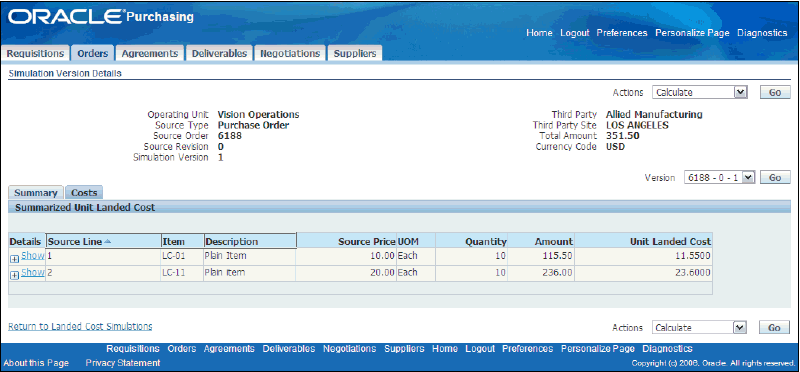
-
Click the Show icon for each Source Line to view details of the summarized landed costs.
For each Source Line, the following information is displayed:
-
Source Price per Item
-
Quantity
-
Total Amount including all components (for example, freight, insurance, labor)
-
Unit Landed Cost
In the details row, the following information is displayed for each shipment line:
-
Source Shipment Line Number
-
Shipment Number
-
Organization Name
-
Organization Location
-
Quantity
-
Total Amount including all components (for example, freight, insurance, labor)
-
Unit Landed Cost
Simulation Version Details page

-
-
Click the Update icon for a Shipment Line to display Landed Cost Details for this Shipment.
Landed Cost Details page

Managing Existent Landed Cost Simulations
To create a new Landed Cost simulation version
You can create a new simulation version to display charges that would result from a different supplier.
-
Navigate to the Landed Cost Simulations page and click the Simulate button.
Landed Cost Simulations page

To copy the data from an existent Landed Cost simulation version into a new one
-
From the Actions menu on the Simulation Version Details page, select Copy and Click Go.
Simulation Version Details page
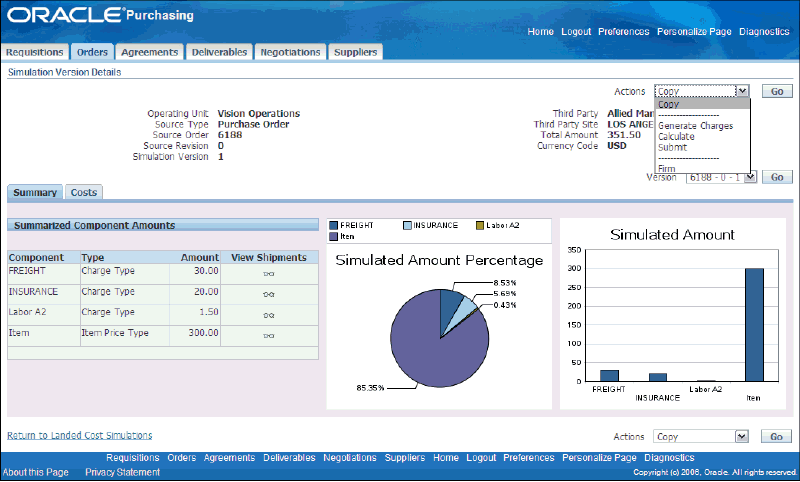
-
From the Version Menu, select Version 2 and click the Go button.
Simulation Version Details page
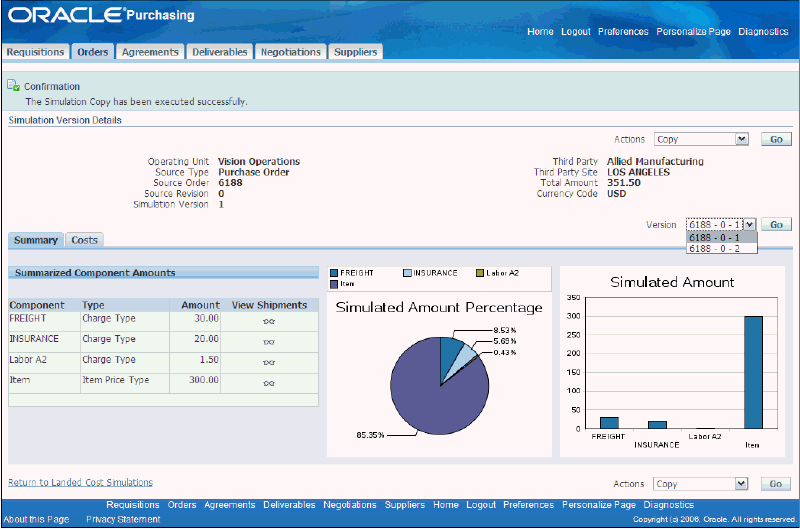
To update the simulation version information
LCM allows you to modify the simulation version information such as third party and freight carrier information in order to determine the most cost effective solution.
-
On the Landed Cost Simulations page, in the Actions column for Version 2, click the Update icon.
Landed Cost Simulations page
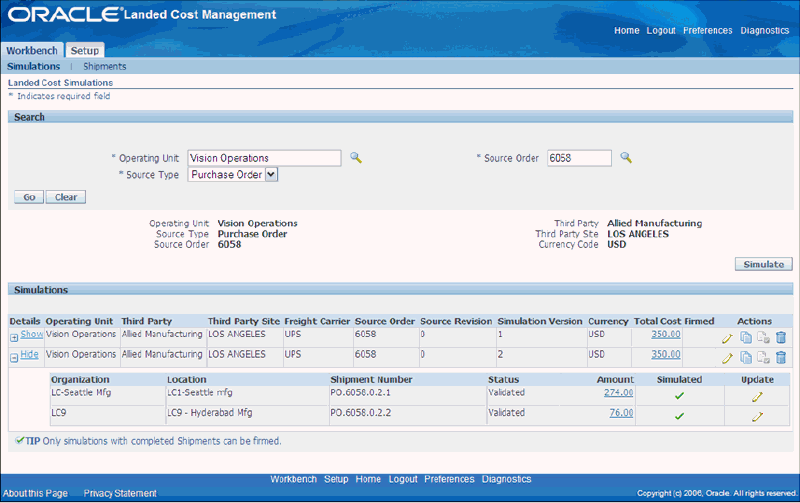
-
On the Update Simulation Version page, query the desired Third Party name and click Apply.
Update Simulation Version page
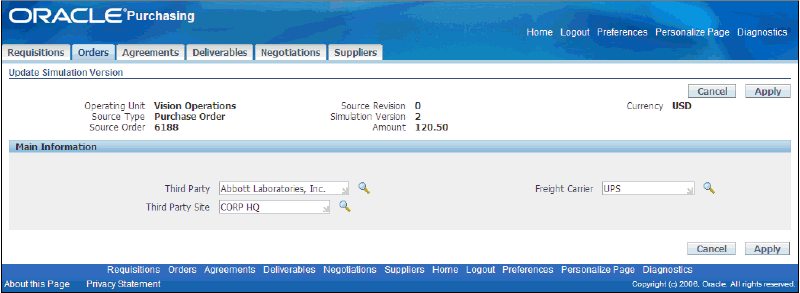
Managing Charges and Simulation Details
LCM allows you to change the simulated shipment information and also the charge information by using the same UI pages used by the shipments workbench in the update mode.
Use the update button from the Landed Cost Detail page or the Update Icon from the following pages:
-
Landed Cost Simulations (detail table row)
-
Landed Cost Version Details (costs tab)
To manage charges and simulation details
-
On the Landed Cost Details page, click the Update button to navigate to the Update Shipment page.
Landed Cost Details page

-
From the Actions menu, select Manage Charges and click the Go button to display the Manage Charges page in order to update the desired Charge Line information.
Please refer to the Managing Charge Lines for the Shipment section of this document for additional information on how to manage charges.
Manage Charges page

To generate charges from LC simulation version
Whenever you modify the charge information from a Landed Cost simulated shipment, you have to calculate the new landed costs in order to view the new information in the simulation workbench pages.
Please refer to the Calculating Estimated Landed Cost for the Shipment. section on this guide for additional information.
-
On the Simulation Version Details page, select Generate Charges from the Actions menu and click the Go button.
Simulation Version Details page
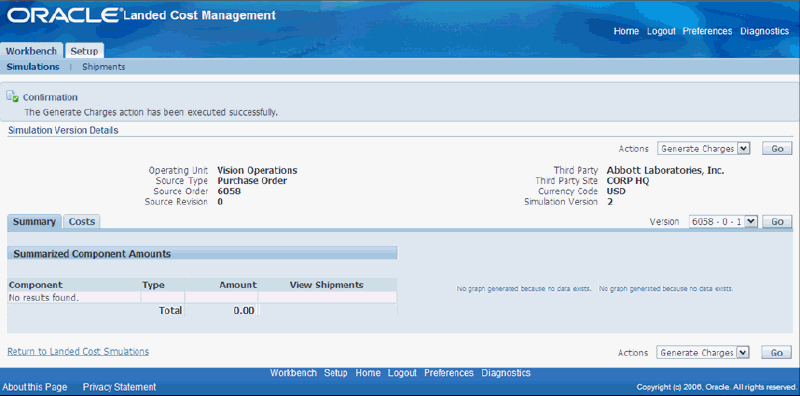
To calculate the landed costs for a Landed Cost simulation
-
Navigate to the Simulation Version Details page and click the Total Cost link for Version 2 to view the Simulation Version Details page.
Landed Cost Simulations page

-
From the Actions menu, select Calculate and click the Go button. When you calculate the simulated version, LCM will run the calculation engine for all the Landed Cost simulated shipments that belong to that simulated version. Alternatively, you can run the calculation for each simulated shipment. To do so, use the same navigation as you edit and use the actions list of value available there. Please refer to the section Managing Landed Cost for additional information.
Simulation Version Details page
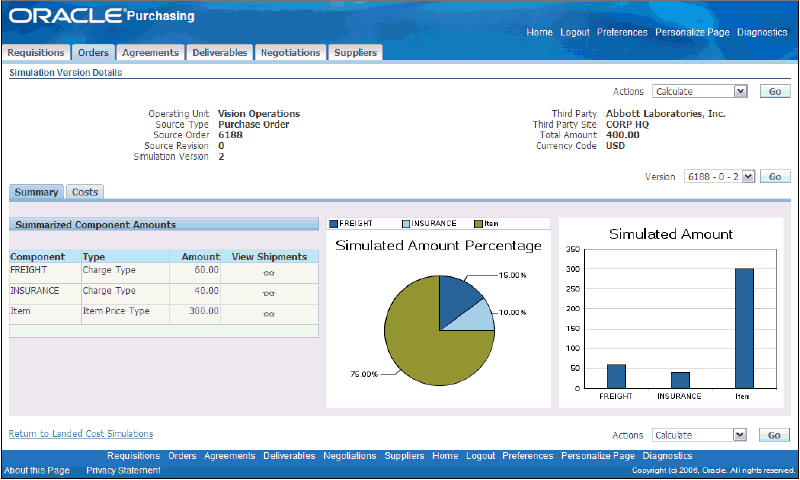
To firm the best Landed Cost simulation
LCM allows you to reuse the charge information from firmed simulations when you are creating the Landed Cost shipments at the time of receipt. To firm a simulation version, you are required to complete, or submit it. When you submit the LC simulated version, you are freezing it from updates and allowing it to be firmed. You should perform this action when you are satisfied with the simulation results and don’t want to update it anymore.
-
From the Actions menu on the Simulated Version Details page, select Submit and click the Go button.
Simulation Version Details page

-
You have the option to firm the simulation from 2 pages. You can select Firm from the Actions menu of the Simulation Version Details page:
Simulation Version Details page

Or you can click on the Firm icon in the Actions column on the Landed Cost Simulations page
Landed Cost Simulations page
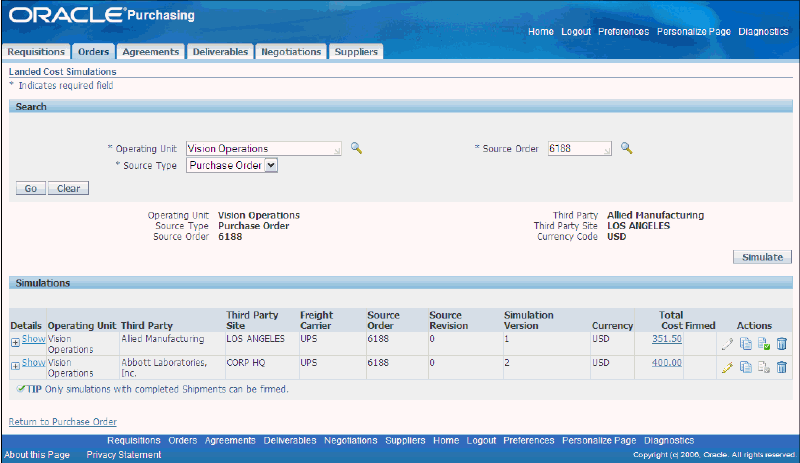
-
On the Landed Cost Simulations page, note that Simulation Version 1 is now firmed.
Landed Cost Simulations page

During the firming process, LCM performs a synchronized validation between the data from the simulation and the source document (e.g.: purchase order). When a discrepancy is recognized by the system, a warning is displayed as follows:
Creating the Estimated Landed Cost Shipment
Once the firmed PO has been approved, you can create the Estimated Landed Cost shipment at receiving time.
To create the estimated Landed Cost shipment
The Landed Cost shipment creation process derives the charges from the firmed LC simulation as demonstrated in the following steps.
For complete information on the Landed Cost shipment creation process, see: Creating Landed Cost Management Shipments.
-
On the Create Shipment page, enter the shipment header information and click the Lines tab.
Create Shipment page

-
Search for the desired purchase order lines, save the shipment, select Generate Charges from the Action menu and click the Go button.
Create Shipment page

-
From the Actions menu, select Calculate and click the Go button.
Create Shipment page

-
From the Actions menu, select View Landed Cost and click the Go button to.
Shipment Hierarchy page
